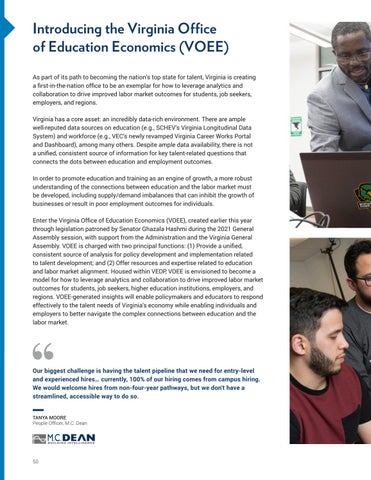Introducing the Virginia Office of Education Economics (VOEE) As part of its path to becoming the nation’s top state for talent, Virginia is creating a first-in-the-nation office to be an exemplar for how to leverage analytics and collaboration to drive improved labor market outcomes for students, job seekers, employers, and regions. Virginia has a core asset: an incredibly data-rich environment. There are ample well-reputed data sources on education (e.g., SCHEV’s Virginia Longitudinal Data System) and workforce (e.g., VEC’s newly revamped Virginia Career Works Portal and Dashboard), among many others. Despite ample data availability, there is not a unified, consistent source of information for key talent-related questions that connects the dots between education and employment outcomes. In order to promote education and training as an engine of growth, a more robust understanding of the connections between education and the labor market must be developed, including supply/demand imbalances that can inhibit the growth of businesses or result in poor employment outcomes for individuals. Enter the Virginia Office of Education Economics (VOEE), created earlier this year through legislation patroned by Senator Ghazala Hashmi during the 2021 General Assembly session, with support from the Administration and the Virginia General Assembly. VOEE is charged with two principal functions: (1) Provide a unified, consistent source of analysis for policy development and implementation related to talent development; and (2) Offer resources and expertise related to education and labor market alignment. Housed within VEDP, VOEE is envisioned to become a model for how to leverage analytics and collaboration to drive improved labor market outcomes for students, job seekers, higher education institutions, employers, and regions. VOEE-generated insights will enable policymakers and educators to respond effectively to the talent needs of Virginia’s economy while enabling individuals and employers to better navigate the complex connections between education and the labor market.
Our biggest challenge is having the talent pipeline that we need for entry-level and experienced hires… currently, 100% of our hiring comes from campus hiring. We would welcome hires from non-four-year pathways, but we don't have a streamlined, accessible way to do so. TANYA MOORE People Officer, M.C. Dean
50













